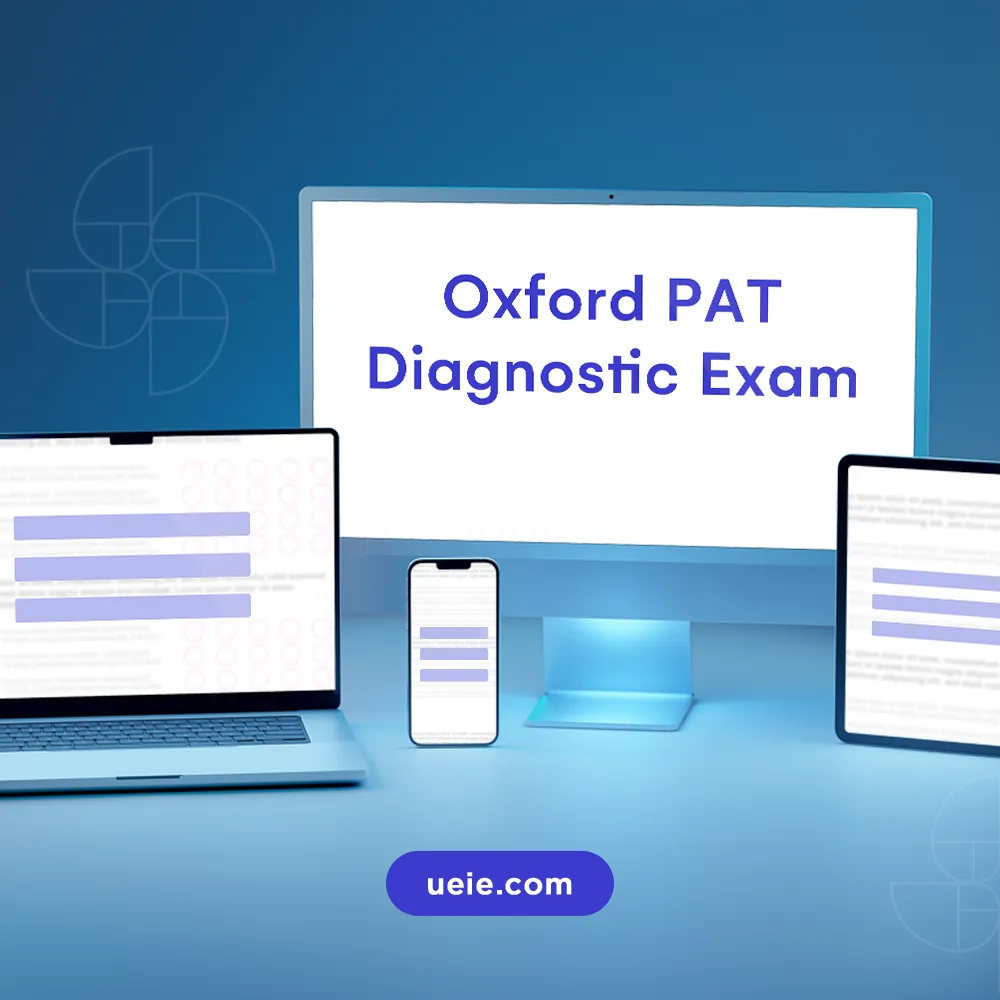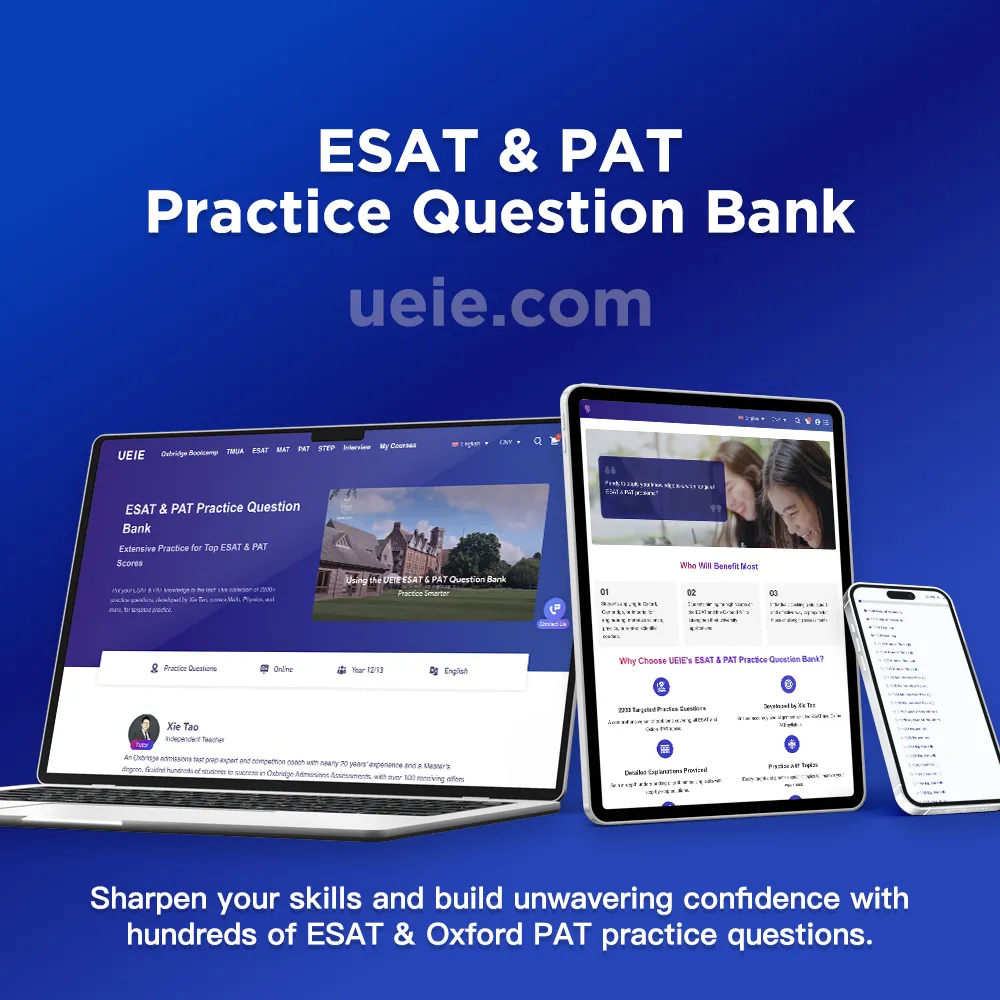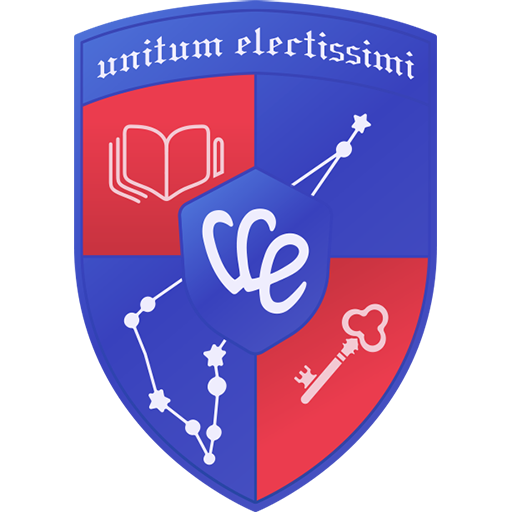Ace the Oxford PAT: Mastering Maths, Physics & Online Test Skills

Independent Teacher
Ace the Oxford PAT: Mastering Maths, Physics & Online Test Skills

For students aspiring to apply for Physics, Engineering Science, or Materials Science at the University of Oxford, successfully navigating the Physics Aptitude Test (PAT) is a crucial step in the application process. With the PAT’s recent transition to a fully online, computer-based examination featuring solely multiple-choice questions, adapting to this new format and preparing efficiently has become a significant challenge for candidates. I hope this Oxford PAT Preparation Guide, authored by me (Mr. Xie Tao) and based on many years of experience coaching students for Oxbridge admissions tests, will provide you with a systematic and practical set of preparation strategies and methods tailored to the latest examination format.
Before delving into this guide, I strongly recommend that you first carefully read Oxford PAT Comprehensive Guide to gain a full understanding of the latest developments, requirements, and marking criteria for the examination.
I. Clarifying Objectives and Self-Assessment for Oxford PAT Preparation
To embark on your Oxford PAT preparation journey, you must first clearly understand your ‘destination’ (target requirements) and your current ‘starting point’ (your own level). This is the prerequisite for formulating any effective preparation strategy.
1. Clarify Target Requirements
PAT scores are crucial for Oxford Physics, Engineering, or Materials Science applications. Though no fixed cutoff exists, PAT results still strongly influence interview selection.
- Consult Official Information: It is imperative to visit the official University of Oxford website and meticulously review the latest and most accurate admissions requirements for your intended year of entry (e.g., 2026).
- Understand the R-Score: In recent years, the Physics Department at Oxford has primarily referred to the R-Score during the shortlisting phase for interviews. Understanding its general calculation method (for specific details, please refer to Oxford PAT Comprehensive Guide) will help you more accurately comprehend the weighting of PAT scores in your application.
- Refer to Historical Data: Oxford PAT Comprehensive Guide also provides data from previous years, such as average PAT scores of applicants and interview shortlisting thresholds. These can serve as a reference when setting your goals.
2. Conduct a Preliminary Self-Assessment
Before commencing systematic preparation, undertaking a Diagnostic Exam is crucial, especially to familiarise yourself with the latest online examination format. This will help you to:
- Experience the Difficulty and Format: Personally try the interface, 40 MCQs (single/multiple-answer), 120-minute time pressure, and online calculator.
- Understand Your Current Standing: Assess your current physics and mathematics knowledge and online MCQ skills. Then identify gaps between your level and the target requirements.
3. How to Conduct a Diagnostic Exam?
Choosing a Test Tool
Prioritise Oxford’s latest online practice tests; they best simulate the real exam.
Alternatively, Alternatively, you can use high-quality mock tests, like UEIE’s Free Oxford PAT Diagnostic Exam. It closely mimics the latest PAT format and difficulty level and helps assess core PAT knowledge and skills effectively. Click below for details and to take the Diagnostic Exam online.

Free Oxford PAT Diagnostic Exam
Note: When using past papers from before 2024 for practice, be aware of their question types. These types, including written sections and non-multiple-choice questions, differ from the current format. Their main value lies in testing knowledge point mastery rather than fully simulating the examination experience.
Simulating a Realistic Environment
- Strictly adhere to the 120-minute time limit.
- Complete the test on a computer to become familiar with screen reading and mouse operation.
- Use only the system-provided online calculator; do not use any personal calculators or consult external materials.
- Choose a quiet, distraction-free environment.
Objective Evaluation and Analysis
- Score yourself objectively based on the marking scheme (multiple-choice questions are typically marked by checking answers).
- Focus on analysing incorrect questions: Was it due to forgotten knowledge points? Unclear concepts? Calculation errors (especially when using the online calculator)? Misinterpretation of the question? Inappropriate multiple-choice strategies?
- Record your weak areas, which will become a focus for subsequent preparation.
4. Set Scientific PAT Score Goals
Combining your target requirements and self-assessment results, you need to set scientific and reasonable preparation goals. It is advisable to follow the SMART principles:
- Specific: Clearly define the PAT score percentage range you aim to achieve (e.g., target above 70%, or strive to reach the average level of admitted students for your target course in previous years).
- Measurable: Your goals should be trackable and measurable through subsequent mock test scores.
- Achievable: Based on your starting point, available time, and anticipated effort, your goals should be attainable through hard work.
- Relevant: Your goals should serve your overall application objective of receiving an interview invitation and, ultimately, an offer.
- Time-bound: Clearly define the deadline for achieving your goals (i.e., the official examination date).
Balancing Ambition with Realism
Goals should be challenging enough to stimulate your potential yet remain realistic. To understand the R-score, a good GCSE background helps alongside the PAT. However, for most students, improving their PAT score is the aspect over which they have the most active control. Remember, the PAT is just one part of the assessment. However, a high score boosts your chances.
5. Adjust Your Mindset and Embrace the Oxford PAT Preparation Challenge
Oxford PAT preparation, especially when adapting to the new format, can present difficulties and setbacks. It is crucial to cultivate a positive mindset:
- Accept the Challenge: View the PAT as an opportunity to enhance your physics thinking, mathematical application, and examination-taking skills.
- Acknowledge the Gap: The purpose of a Diagnostic Exam is to identify problems; the score, whether high or low, merely represents your starting point.
- Focus on the Process: Concentrate on mastering knowledge, improving skills, and optimising strategies.
- Maintain Resilience: Encountering difficult problems or performing poorly in mock tests is normal. The key is to analyse the reasons, learn from the experience, and persevere.
II. Knowledge Base Required for Oxford PAT Preparation
Precisely grasping the knowledge requirements of the PAT is the first step in formulating an effective preparation strategy. You need to know what’s tested, what’s excluded, and how to prepare based on your background.
1. PAT's Requirements for A-Level Knowledge
The PAT syllabus is based on the UK’s A-Level curriculum but has its specific scope and emphasis:
- Core Scope: Focuses on A-Level Maths Pure topics and AS Physics, plus some A2 Physics content.
- No Further Mathematics: The PAT does not include content from A-Level Further Mathematics. This is to ensure fairness to students who have not studied Further Mathematics. Therefore, there is no need to invest effort in learning Further Mathematics topics specifically for the PAT.
- Depth over Breadth: Although the syllabus may appear concise, the PAT does not simply test the recall of knowledge points. It requires profound understanding of syllabus core physical principles and mathematical tools, and flexible application in novel complex multiple-choice scenarios.
2. Knowledge Alignment for Students from Different Curricula
Students following non-A-Level curricula, such as AP or IB, need to proactively compare and supplement their knowledge:
AP Curriculum Students
- Typically, AP Physics C: Mechanics and AP Physics C: Electricity and Magnetism, or AP Physics 1 and 2, cover most of the PAT Physics syllabus content.
- However, check official PAT syllabus for omissions or differing emphases, e.g., basic astronomy, and cross-reference algebra/trig topics as AP Calculus BC coverage may be incomplete.
IB Curriculum Students
- IB DP Physics HL usually covers the PAT Physics knowledge range well. However, there might be issues with the pace of learning, as some A2 content required for the PAT may be taught later in the IB programme, necessitating early self-study.
- IB Mathematics (AA HL or AI HL) may have different content emphases compared to A-Level Mathematics. Similarly, it is essential to check for and fill any gaps against the PAT mathematics syllabus.
Core Recommendation
Regardless of your curriculum, the most authoritative standard is always the latest examination syllabus released by the PAT authorities. Be sure to download the syllabus, check it item by item, and develop a detailed knowledge supplementation plan to ensure all required content is covered.
3. The Role of Physics Competition Background and Coping Strategies
Competition Advantage
In recent years, the difficulty and style of PAT questions have indeed shown a trend towards those found in physics competitions (such as the British Physics Olympiad, BPhO Round 1). Students with relevant competition experience may have an advantage in handling complex physical scenarios and employing multiple methods to solve problems, and their thinking tends to be more flexible.
Not a Prerequisite
However, it must be emphasised that a physics competition background is by no means a prerequisite for taking the PAT or achieving a good score. The core of the PAT remains the assessment of a profound understanding and application of the knowledge within the syllabus.
Coping Strategies
- For Students with a Competition Background: You can leverage the problem-solving skills and physical intuition developed through competitions. However, you still need to systematically review the PAT syllabus to ensure a solid foundation and practise online multiple-choice questions specifically.
- For Students without a Competition Background: There is no need for anxiety. The focus of your preparation should be on thoroughly understanding the PAT syllabus knowledge and enhancing your physics thinking and mathematical application skills. If time and energy permit, you can engage with some high-quality challenging problems through officially recommended resources (such as Isaac Physics or some past BPhO questions), focusing on learning their problem-analysis methods and thought processes. The aim is to broaden your thinking, not to systematically learn competition-specific knowledge.
III. Core Competencies Essential for High PAT Scores (Under the New Format)
Mastering the knowledge required by the PAT syllabus is fundamental, but this alone is not sufficient to guarantee a high score. Especially with the transition to an online, purely multiple-choice format, you also need to hone the following key core competencies to stand out in the fierce competition.
1. Profound Understanding of Physics Concepts and Physical Intuition
This remains the core of what the PAT assesses. Regardless of how question types change, a deep understanding of fundamental physical concepts and laws is the cornerstone for solving complex problems. You need to:
- Go Beyond Formula Memorisation: Not only memorise formulae but also understand their physical meaning, conditions for applicability, and derivation logic.
- Build Physical Pictures: Be able to quickly translate the scenario described in a question into a clear physical model.
- Cultivate Physical Intuition: Possess a keen insight into physical phenomena, enabling you to quickly identify the crux of a problem and the likely main physical processes involved (sometimes referred to as ‘nous’ or ‘insight’).
2. Solid Application of Mathematical Knowledge and Problem-Solving Skills
A significant number of PAT questions require the application of A-Level mathematical knowledge to analyse and calculate physical problems. You need to possess:
- Proficient Use of Mathematical Tools: Flexibly apply algebraic, geometric, trigonometric, and calculus methods to solve physics calculations.
- Accurate and Swift Calculation: Maintain accuracy and a reasonable speed in calculations under time pressure and without the aid of pen-and-paper derivations (some rough work can be done on paper). Although an online calculator is provided, it is not suitable or efficient for every step.
3. Efficient Strategies and Techniques for Online Multiple-Choice Questions
This is one of the most critical skills under the new format. With 40 multiple-choice questions (including single-best-answer and multiple-answer questions) to be completed in 120 minutes, averaging only 3 minutes per question, mastering efficient strategies is essential:
- Rapid Question Comprehension and Modelling: Quickly grasp the core information of the question, construct the correct physical model, and determine the necessary formulae and methods.
- Option Analysis and Elimination: Utilise physical intuition, dimensional analysis, special values/extreme cases, and estimation to quickly assess the plausibility of options, prioritising the elimination of obviously incorrect distractors.
- Beware of Question Traps and Easily Confused Concepts.
- Addressing Single-Best-Answer and Multiple-Answer Questions: Clearly understand the question’s requirement (select one best answer or all correct answers) and adjust your problem-solving strategy accordingly. Multiple-answer questions require more thorough consideration and verification.
- Time Management and Decision-Making: Quickly assess the difficulty of a question, decisively skip (and mark) challenging problems for which you have no immediate ideas, avoid getting ‘stuck’ on a question, and ensure you complete all questions you are confident about. Learn when to make educated guesses if necessary (there is no negative marking).
4. Proficiency in Using the Online Calculator
Unlike in the past, you must now exclusively use the online calculator provided within the examination system. You need to:
- Familiarise Yourself with its Functions and Limitations: Through the official online practice platform, thoroughly understand the specific functions of the online calculator (such as button layout, order of operations, supported functions) and its limitations.
- Enhance Operational Efficiency: Practise inputting numbers and performing operations quickly and accurately within the online interface to minimise operational errors.
- Judge When to Use it Appropriately: Balance the use of the online calculator, mental arithmetic, and paper-based rough calculations, choosing the most efficient method to complete calculation tasks and avoiding unnecessary time spent on operations.
5. Ability to Adapt to the Online Examination Environment and Screen Reading
Engaging in high-intensity mathematical and physical thinking whilst looking at a screen for an extended period tests concentration and stamina. You need to:
- Familiarise Yourself with the Examination Interface: Through official online practice tests, become accustomed to the Pearson VUE examination interface, question presentation format, option selection method, flagging function, time display, etc.
- Improve Screen Reading Efficiency: Practise reading complex physics and mathematics questions containing diagrams or special symbols on a screen, maintaining focus and accuracy of comprehension.
- Coordinate Online and Offline Operations: Efficiently switch between screen reading, online calculator operation, and using paper for rough derivations and calculations.
IV. Core Oxford PAT Preparation Strategies and Resource Utilisation (Under the New Format)
Clear strategies and the effective use of resources are key to efficient PAT test preparation. This requires a phased, focused process that is fully adapted to the new online multiple-choice format.
1. Core Principle: Understanding-Based, Proficient Application, Adaptation to Computer-Based Testing
- Profound Understanding is a Prerequisite: The PAT does not simply test knowledge recall but deeply assesses physical understanding and mathematical application skills. The core of preparation should lie in building a profound understanding of the concepts and principles within the syllabus.
- Proficient Application is Key: Building on understanding, you need to transform knowledge into the ability to solve problems quickly and accurately in the online multiple-choice format through extensive high-quality practice.
- Adaptation to Computer-Based Testing is a Safeguard: Preparation must be tailored to the characteristics of the online examination, including familiarisation with the interface, practice with the online calculator, and the ability to efficiently read and think about physics and mathematics problems on screen.
2. Phase 1: Knowledge Organisation and Foundation Consolidation (Early Preparation)
Objective
Systematically review the physics and mathematics knowledge points covered by the PAT syllabus, ensure there are no blind spots, achieve a profound understanding of core concepts, and reinforce the precision of basic calculations.
Actions
- Referencing the latest official syllabus, organise knowledge modules one by one.
- Practise basic calculations and typical example problems, especially simulating an environment where you rely minimally on pen and paper (using scrap paper for auxiliary thinking).
- Use A-Level textbooks, reliable online resources (such as relevant sections of MEI, Khan Academy), or systematic courses, like UEIE’s Oxford PAT Video Lecture Series, for learning or consolidation.
Resources

ESAT & PAT Video Lecture Series
US$282 – US$1 136Price range: US$282 through US$1 136
3. Phase 2: Specialised Training and Skill Enhancement (Mid-Preparation - Crucial Stage)
Objective
Undertake specialised training focused on the characteristics of PAT online multiple-choice questions to improve problem-solving speed, accuracy, application of multiple-choice strategies, efficiency in using the online calculator, and adaptability to the online environment.
Actions
- Thoroughly Study Official Resources: Prioritise using the online practice tests/sample questions provided by the University of Oxford, as this is the best way to familiarise yourself with the real interface and question types.
- Targeted Breakthroughs: Engage in extensive, targeted online multiple-choice question practice (especially multiple-answer questions). You can utilise the Isaac Physics platform and UEIE’s Oxford PAT Practice Question Bank (online) for specialised practice and gradually adapt to the online answering format.
- Strengthen Core Competencies: Deliberately practise the various core competencies mentioned in the previous section, such as multiple-choice techniques (elimination, estimation, special values, etc.), rapid and accurate operation of the online calculator, and screen reading concentration. Conduct timed training.
- Resource Utilisation: The official sources only provide past papers without solutions. Furthermore, past papers from before 2024 are not entirely in a multiple-choice format, so they need to be used selectively. However, these past papers can still be used to test understanding and application of knowledge points. When practising, try to convert their thought processes into multiple-choice solutions or judgments.
Resources

ESAT & PAT Practice Question Bank
US$1 036 Original price was: US$1 036.US$868Current price is: US$868.
4. Phase 3: Online Simulation and State Adjustment (1-2 Months Before the Exam)
Objective
Comprehensively simulate the real online examination environment, assess overall preparation levels, optimise examination strategies (time allocation, answering pace), identify and rectify weaknesses, and adjust to an optimal examination state.
Actions
- Strict Full-Length Mock Exams: Use the latest official online practice tests (if complete sets are available) or high-quality online full-length mock exam papers, such as UEIE’s Oxford PAT Full-Length Mock Exams, which include 4 original online mock papers, for rigorous simulation.
- Simulation Requirements: Strictly adhere to the 120-minute time limit; complete on a computer; use only the online calculator; ensure a quiet, distraction-free environment. It is recommended to complete at least 3 high-quality mock exams.
- Strategy Rehearsal: In mock exams, practise time allocation (average 3 minutes/question, how to reserve time for checking), strategies for dealing with difficult questions (marking, skipping, guessing), and procedures for the checking phase.
- In-depth Review and Adjustment: After each mock exam, carefully analyse the reasons for incorrect answers, review time allocation, summarise lessons learnt, and address knowledge or skill shortcomings in a targeted manner. Adjust your mindset and build confidence.
Resources
5. Core Recommendations for Selecting Preparation Resources
- Official Resources First: Always prioritise PAT information published by the University of Oxford. Core resources include the PAT syllabus, official online practice tests/sample questions, past papers, official annual reports and preparation advice, and course materials.
- Systematic Support: Consider using systematic PAT preparation resources, such as those provided by UEIE (video courses, Practice Question Bank, full-length mock exams). These materials are based on the many years of teaching experience of expert tutors, integrated and optimised to effectively supplement official resources and improve preparation efficiency.
- Selective Expansion: Based on individual needs, selectively use other high-quality supplementary resources, such as the Isaac Physics website, BPhO Round 1 past papers, etc. Avoid an overabundance of resources, which can dilute focus and energy. Quality over quantity.
- Active Learning: For any resource, engage in active thinking, in-depth review, and summarisation to internalise it into your own abilities.
Resources

ESAT & PAT On-Demand Prep Suite
US$609 – US$2 416Price range: US$609 through US$2 416
V. How to Plan Your Oxford PAT Preparation Time?
‘How long does Oxford PAT preparation take?’ This is a question many students are concerned about. The scope of knowledge for the PAT is relatively concentrated, but its demands on physics thinking, mathematical application, and adaptation to the new online multiple-choice format also require ample time for preparation and refinement. Sensible planning is key to success.
1. Core Influencing Factors
The amount of preparation time you need primarily depends on the following factors:
- Target Score: Aiming for top-tier scores (e.g., 75+) usually requires longer and more detailed refinement than reaching the average interview threshold (e.g., 60+).
- Starting Level: Your current foundation in physics and mathematics, and the gap between your core competencies and PAT requirements.
- Available Time: How many hours per week you can consistently dedicate to efficient preparation.
- Learning Efficiency: The speed at which you absorb knowledge and master skills, and the effectiveness of your methods.
2. Recommended Oxford PAT Preparation Periods for Different Starting Points
The following are general recommendations based on common student backgrounds. Please note these are only references; consistent and effective effort is more important than sheer duration:
Students with a Solid Physics/Mathematics Foundation (with experience in mathematics or physics competitions):
- Focus: Adapting to the specific PAT syllabus, online multiple-choice style, time pressure, and the online calculator.
- Recommendation: Begin targeted training approximately 3-4 months before the examination (e.g., start in late June or early July for an October exam).
A-Level Curriculum Students (without competition experience):
- Focus: Consolidating physics and mathematics foundations, engaging in extensive online multiple-choice practice to improve speed, accuracy, and strategy, and fully adapting to the online examination environment.
- Period: It is advisable to start systematic preparation no later than 4-6 months before the examination (e.g., begin in May or early June). You will need to go through a complete cycle of ‘knowledge consolidation → specialised online practice → online mock exam sprint.’
AP/IB Curriculum Students (without competition experience):
- Focus: In addition to the challenges faced by A-Level students, extra time is needed for identifying and addressing knowledge gaps (by comparing with the PAT syllabus). More time may also be required to adapt to the A-Level system’s question style and the online examination mode.
- Period: It is strongly recommended to start earlier, ensuring at least 5-6 months or even longer for preparation (e.g., late April or early May, or even earlier).
Core Tip
Starting early always offers an advantage, allowing for a more composed approach to each preparation phase. The key lies in consistency and learning efficiency.
3. Balancing Preparation with Daily Academic Work: Practical Tips
For students currently in school, efficiently balancing Oxford PAT preparation with coursework is crucial:
- Fixed Schedule: Incorporate PAT test preparation into your weekly study timetable as if it were a formal subject.
- Utilise Holidays: Use weekends and school holidays (especially the summer break) for concentrated knowledge review, tackling difficult areas, or simulation training.
- Focused Efficiency: During allocated PAT study periods, maintain high concentration and strive for efficiency per unit of time.
- Flexible Adjustments: During busy periods such as school examinations or the application season, you can appropriately adjust the intensity of PAT preparation but try to maintain a certain amount of practice to keep your ‘hand in.’ Catch up promptly afterwards.
- Work-Life Balance: PAT preparation is a marathon. Ensure adequate sleep and moderate relaxation to avoid fatigue, which can lead to decreased efficiency and burnout.
VI. Common PAT Preparation Misconceptions and Countermeasures (Under the New Format)
1. Misconception 1: Starting Too Late, Lack of Planning
Manifestation and Consequences
Underestimating the demands of the PAT on physics and mathematics abilities, particularly the time required to adapt to the online multiple-choice format, and only starting to prepare hastily close to the examination. This leads to an unstable foundation, insufficient practice, and an inability to adapt to the examination rhythm.
Countermeasure
Plan early, invest consistently! Recognise that Oxford PAT preparation (especially skill enhancement and adaptation to the new format) requires accumulated time. Refer to the recommendations in Section V, formulate a detailed, phased preparation plan, and ensure consistent, effective study input each week.
2. Misconception 2: Neglecting Online Platform Features, Disconnect Between Practice and Actual Exam
Manifestation and Consequences
Relying mainly on paper-based practice, lacking familiarity with the Pearson VUE online examination platform’s interface and operational methods (such as flagging, navigation), and the use of the online calculator (functionality, speed, precision); not being accustomed to prolonged screen reading and answering.
Countermeasure
- Frequently use official online practice tests: This is the best way to familiarise yourself with the real environment and must be used repeatedly.
- Specific practice with the online calculator: Train this as an independent skill to achieve proficiency, speed, and accuracy.
- Simulate the online environment: Conduct daily practice and mock exams on a computer as much as possible to cultivate screen reading stamina and concentration.
3. Misconception 3: Lack of Effective Multiple-Choice Strategies and Techniques
Manifestation and Consequences
Treating multiple-choice questions as simple knowledge checks, lacking coping techniques; being prone to errors when facing distractors; not differentiating strategies for single-best-answer and multiple-answer questions; poor time allocation, spending too much time on difficult questions or working too slowly (far exceeding the average of 3 minutes per question).
Countermeasure
- Systematically learn techniques (elimination, estimation, extreme cases, dimensional analysis, etc.).
- Undertake extensive timed multiple-choice training to improve speed and accuracy.
- Summarise problem-solving approaches for different types of multiple-choice questions (physics concept discrimination, calculation, comprehensive application).
- Practise time management and trade-off strategies (when to skip, when to guess) in mock exams.
4. Misconception 4: Weak Grasp of Knowledge or Unskilled Application
Manifestation and Consequences
Having a superficial understanding of basic concepts and formulae within the syllabus, relying on rote memorisation; being unable to flexibly apply knowledge to question scenarios, and struggling to find a solution path even for multiple-choice questions.
Countermeasure
- During the initial preparation phase (Phase 1), ensure a solid grasp of fundamental knowledge, understanding physical principles and mathematical methods.
- During practice (Phase 2), do not just check answers; review the problem-solving process, consider how knowledge points are applied, and try to find multiple solutions to a single problem.
5. Misconception 5: Unbalanced Mindset, Improper Stress Management
Manifestation and Consequences
Feeling excessively anxious about the difficulty, time constraints, or online format of the PAT; being prone to mental breakdown and self-doubt when encountering setbacks (such as unsatisfactory mock exam results or inability to solve difficult problems), affecting the continuity of preparation.
Countermeasure
- Set reasonable, achievable goals (refer to Section I).
- Accept that challenges and setbacks are a normal part of preparation; focus on your own progress rather than making blind comparisons.
- Practise thinking under pressure, maintain a moderate level of tension, and avoid excessive anxiety.
- Balance work and rest to ensure the sustainability of your preparation.
6. Misconception 6: Misuse of Resources or Lack of Information
Manifestation and Consequences
Relying on outdated or unsuitable preparation materials for the new format (e.g., only using old paper-based past papers); not paying attention to the latest information released by official sources (such as syllabus updates, sample questions, online test updates); blindly collecting numerous resources without knowing how to use them effectively, leading to dispersed energy.
Countermeasure
- Focus on the latest information and online preparation resources released by the University of Oxford as your core materials.
- Critically use past papers (mainly for content understanding, not format simulation).
- Selectively use high-quality supplementary resources that match the current examination format (such as Isaac Physics, UEIE series materials, etc.).
- Quality over quantity in resources; focus on using core materials deeply and thoroughly.
VII. Final Words: Mindset and Action
By now, you should have a systematic understanding of how to prepare for the PAT test in its new format. As I conclude this guide, allow me to re-emphasise the importance of mindset and outline the key actions for you to take next.
1. Embrace the Challenge: Essential Preparation Mindset
The Oxford PAT preparation journey is inevitably filled with challenges. A strong psychological constitution is a key guarantee for reaching your goal. Please be sure to cultivate the following mindsets:
- Face Setbacks, Build Resilience: Encountering difficult problems, performing poorly in mock exams, or struggling with online operations are all normal occurrences. The key is to view them as opportunities to identify problems, learn lessons, and improve yourself.
- Focus on Deep Work, Maintain Consistent Effort: The improvement of physical intuition and problem-solving skills is not achieved overnight. Ensure high-quality, continuous study input to achieve gradual progress.
- Maintain Equanimity, Balance Mind and Body: Focus on your own progress, learn to manage the additional stress that online examinations may bring, balance work and rest, and ensure the sustainability of the preparation process.
- Find Joy in It, Drive Perseverance: Try to discover the joy in tackling challenging physics and mathematics problems and appreciate their logical beauty. When you can enjoy the process, perseverance will become more natural and enduring.
2. Action Speaks Louder Than Words: Next Step Recommendations
Having clarified your mindset and methods, the next crucial step is to translate cognition into tangible action. I recommend that you:
- Act Immediately: Based on the advice in this guide, refine and execute your preparation plan.
- Utilise Resources Wisely: Use official materials as your core and efficiently leverage selected supplementary resources.
- Practise and Reflect Continuously: Persist with high-quality practice and regularly review, summarise, and adjust.
Finally, please believe in yourself. Thorough preparation and a positive mindset will be your most powerful weapons in tackling the PAT challenge. I wish you success in conquering the PAT through your wisdom and hard work, and in entering the academic institution of your dreams!
Follow Us on Wechat

- Categories Admissions Tests
- Tags Apply to Oxford University, Engineering Course, Exam Prep Guide, Oxford PAT, Physics Course


